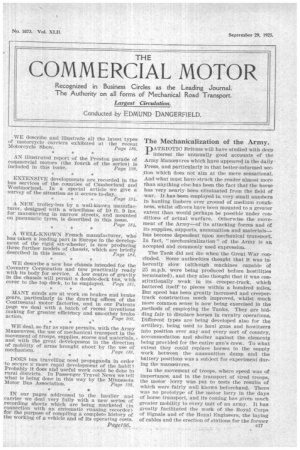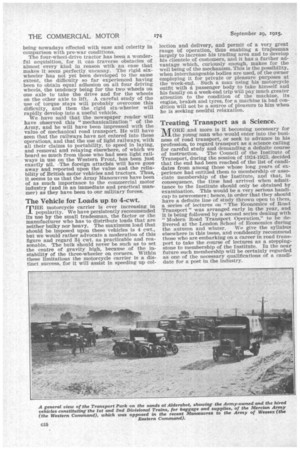The Mechanicalization of the Army.
Page 1

Page 2

If you've noticed an error in this article please click here to report it so we can fix it.
DATRIOTIC Britons will have studied with deep interest thefl unusually good accounts of the Army Manteuvres which have appeared in the daily Press, and particularly in that better-informed secVon which does not aim at the mere sensational. And what must have struck the reader almost more than anything else has been the tact that the horse has very nearly been eliminated from the field of war. It has been employed in very small numbers in hauling limbers over ground of medium roughness, whilst officers have been mounted to a greater extent than would perhaps be possible under conditions of actual warfare. Otherwise the movement of the Army—of its attacking forces and of its supplies, supports, ammunition and materials— has become dependent upon mechanical transport. In fact, " naechanicalization" of the Army is an, accepted and commonly used expression.
The Tank did not die when the Great War concluded. Some authorities thought that it was inherently slow (although machines capable of 25 m.p.h. were being produced before hostilities terminated), and they also thought that it was constitutionally weak in its creeper-track, which battered itself' to pieces within a hundred miles. But speed has been greatly increased and creepertrack construction much improved, whilst much more common sense is now being exercised in the ,methods of employing the Tanks. They are bidding fair to displace horses in cavalry operations. Different types are being developed also for the artillery, being used to haul guns and howitzers into position over any and every sort of country, accommodation and shelter against the elements being provided for the entire gun's crew. To what extent they could replace horses in the supply work between the ammunition dump and the battery positions was a subject for experiment during the manoeuvres.
In the movement of troops, where speed was of importance' and in the transport of tired troops., the motor lorry was put to tests the results of which were fairly well known beforehand. There was no prototype of the motor lorry in the days of horse transport, and its coming litis given much greater mobility to every unit of an army. It has greatly facilitated the work of the Royal Corps of Signals and of the Royal Engineers, the laying of cables and the erection of stations for the former being now effected with ease and celerity in comparison with pre-war conditions.
The four-wheel-drive tractor has been a wonderful acquisition, for it can traverse obstacles of almost every kind in reason with an ease that makes it seem perfectly uncanny. The rigid sixwheeler has not yet been developed to the same extent, the difficulty so far experienced having been to obtain equal adhesion on all four driving wheels, the tendency being for the two wheels on one axle to take the drive and for the wheels on the other axle to lift. A careful study of the use of torque stays will probably overcome this difficulty, and then the rigid six-wheeler will rapidly develop into a useful vehicle.
We have said that the newspaper reader will have observed this " mechanicalization " of the Army, and he will have been impressed with the value of mechanical road transport. He will have seen that the railways have not entered into these operations, and that the use of light railways, with all their claims to portability, to speed in laying, and removal and relaying elsewhere, of which we heard so much from those who had seen light railways in use on the Western Front, has been just exactly nil. The foreign attaches will have gone away and reported upon the value and the reliability of British motor vehicles and tractors. Thus, it seems to us that the Army Manoeuvres have been of as much importance to the commercial motor industry (and in an immediate and practical manmer) as they have been to our military forces.
The Vehicle for Loads up to 4-cwt. The Vehicle for Loads up to 4-cwt.
THE motorcycle carrier is ever increasing in popularity. We have persistently recommended its use by the small tradesman, the factor or the manufacturer who has to distribute loads that are neither bulky nor heavy. The maximum load that should be imposed upon these vehicles is 4 cwt., but we would rather advocate a moderation of this figure and regard 3i cwt. as practicable and reasonable. The bulk should never be such as to set the centre of gravity high, because of the instability of the three-wheeler on corners. Within these limitations the motorcycle carrier is a distinct success, for it will assist in speeding up col lection and delivery, and permit of a very great range Of operation, thus enabling a tradesman largely to increase his trading area and to develop his clientele of customers, and it has a further advantage which, curiously enough, makes for the well being of the mechanism. This is the possibility, when interchangeable bodies are used, of the owner employing it for private or pleasure purposes at the week-end. Such a man using his motorcycle outfit with a passenger body to take himself and his family on. a week-end trip will pay much greater attention to the condition of the machine, its engine, brakes and tyres, for a machine in bad condition will not be a source of pleasure to him when he is seeking needful relaxation.
Treating Transport as a Science.
MORE and more is it becoming necessary for the young man who would enter into the business of road transport, or seek to advance in his profession, to regard transport as a science calling for careful study and demanding a definite course of instruction. The Council of the Institute of Transport, during the session of 1924-1925, decided that the end had been reached of the list of candidates from among those whose long years of experience had entitled them to membership or associate membership of the Institute, and that, in consequence, the time had arrived when admittance to the Institute should only be obtained by examination. This would be a very serious handicap to newcomers ; hence, in order that they should have a definite line of study thrown open to them, a series of lectures on " The Economics of Road Transport" was arranged early in the year, and It is being followed by a second series dealing with "Modern Road Transport Operation," to be delivered at the London School of Economics during the autumn and winter. We give the syllabus elsewhere in this issue, and confidently recommend those who are embarking on a career in road transport to take the course of lectures as a steppingstone to membership of the Institute. In the near future such membership will be certainly regarded as one of the necessary qualifications of a candidate for a post in the industry.






























